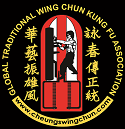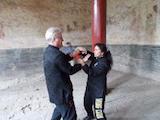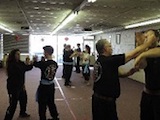

The origin of Wing Chun Kung Fu can be found in the turbulent, repressive Ching dynasty of over 250 years ago.
It was a time when 90% of the Chinese race, the Hons, were ruled by the 10% minority, the Manchus.
The Manchus enacted many unjust laws against the Hons. Amongst them, the work opportunity of the Hons was restricted,
and Kung Fu training was banned along with carrying of weapons.
After weapons were outlawed by the Manchus, the Hons began training a revolutionary army in the secret art of Kung Fu.
The Shil Lim Temple became the secret sanctuary for the preparatory training of the classic style which took 15 to 20 years for each person to master.
To develop a new style, with a shorter training time, five of China's grandmasters met to discuss the merits of each of the various forms of Kung Fu.
By choosing the most efficient techniques from each style, they developed training programs that would develop an efficient martial artist in 5 to 7 years,
one-third the original time. However before this new form could put into practice, the Shil Lim Temple was raided and burned by the Manchus.
Ng Mui, a Buddist nun, was the only survivor of the original five grandmasters. Ng Mui developed techniques and forms for the fighting style envisioned by the five grandmasters. She passed her
knowledge onto a young orphan girl whom she adopted and named Yim Wing Chun.
The name means "Hope For The Future".
In turn Yim Wing Chun passed her knowledge to her husband, Leung Bok Chao. Through the years the style became known as Wing Chun. Its techniques and teachings were passed onto a few carefully selected students. After Yim Wing Chun passed away, Leung Bok Chao taught his nephew Wong Wah Bo.
Wong Wah Bo joined the Red Junk Opera Company and taught Leung Yee Tai who was an actor in the company. Leung Yee Tai and Wong Wah Bo both taught Leung Jan who in turn became famous for his skill in Wing Chun kung fu. Leung Jan opened an herbal shop in Fatshan, where he practiced medicine. At night he trained his sons and Chan Wah Shun. After Leung Jan passed away, Chan Wah Shun took over the instruction of Wing Chun and Leung Bik left the province. In time, Chan Wah Shun accepted Yip Man as his last disciple.
In 1950 Yip Man started to teach Wing Chun in Hong Kong. One of his first students was William Cheung, now Grandmaster of Traditional Wing Chun and head of the Global Wing Chun Kung Fu Association.

The Traditional Wing Chun system can be used in close quarter or distant fighting, and utilizes the following principles:
Guarding the center forces your opponent to take a longer route in order to attack. Your opponent must strike in an arc, giving you extra time and the advantage of opening the opponent's center.
There is an imaginary line drawn down the center of the body. This is called the centerline. This line should face the point of the attacking limb, placing your body behind the defending arm. If you block a forceful circular punch with only the arm, it can collapse.
Try to defend and attack with minimum movement. In Wing Chun a defense is turned into an attack immediately, sometimes simultaneously.
Chi Sao (sticking hands) exercises teach sensitivity and contact reflexes. These exercises teach how to react when contact is made with the arms. You will also learn how to interrupt your movements enabling you to change direction instantly.
Watching the opponents leading elbow will enable you to interpret the angle of attack. The elbow travels at least four times slower than the fist in a circular attack, and at least two times slower that the fist in a linear attack. The elbow is also far enough away to give you time to react. No matter what movement your opponent makes his/her elbow will move.
Striking along the centerline forces your opponent to take the longer outside route to strike, giving you the advantage of making first contact.
Never fight or resist a strong oncoming force, rather redirect it in a harmless direction. The result will be an advantageous position for a counterattack.
You will learn how to use both sides of your brain. The right side of your brain controls the left side of your body and vice versa. Once you learn how to use both arms independently you will be able to defend and counter attack almost simultaneously.

... FREE introductory lesson available ...
... save money with monthly discounts ...